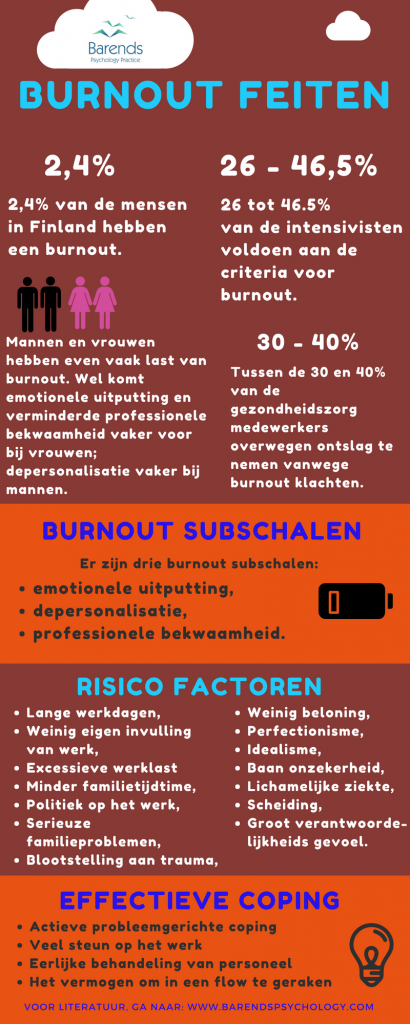Burnout treatment
Burnout is a mental and physical condition characterized by extreme fatigue, emotional exhaustion, depersonalization, and reduced professional accomplishment. Burnout treatment, in general, focuses on the reduction of burnout symptoms, preventing future burnout by learning coping skills, and on slowly getting back to work. Not every burnout treatment is effective or takes much longer than other treatment options. This page focuses on effective burnout treatments and explains how they work and why.
Due to the fact that there are three burnout subscales and that an individual does not need to score high on all three subscales to meet the criteria for burnout, it is likely that different burnout treatment approaches work better than others, depending on the individual subscale scores. Usually, a slight adjustment in the treatment plan is enough to achieve this.
Go to:
At Barends Psychology Practice, we treat Burnout. Go to contact us to schedule a first, free of charge, session. (Depending on your health insurance, treatment may be reimbursed).
Burnout treatment – psychotherapy
Psychotherapy is the use of psychological methods with aim to reduce psychological symptoms, treat mental disorders, and to learn new coping skills. Examples of effective psychotherapies are Cognitive Behavioural Therapy, Eye Movement Desensitization and Reprocessing (EMDR), and Acceptance and Commitment Therapy. Psychotherapy is effective in treating burnout, in the reduction of burnout symptoms, and in the prevention of burnout.
Individuals with burnout who had 14 Cognitive Behavioral Therapy (CBT) sessions reported significantly reduced cortisol (stress hormone) levels compared to individuals with burnout who did not have any kind of treatment [6]. Their cortisol levels in the morning were lower than before treatment and these individuals reported less subjective complaints. Reduced stress levels are associated with less burnout symptoms.
In another study, Cognitive behavioral Therapy reduced the burnout symptoms and self-reported cognitive difficulties, and improved their general health. Their performance on cognitive tests (updating, inhibition, and switching), however, did not improve after 10 weeks of CBT [7]. These findings are supported by another study where researchers found a reduction of burnout in 64.64% of the participants [4] and/or emotional exhaustion, a burnout sub scale [3] after applying CBT. Mindfulness is also effective in the reduction of burnout symptoms (also 64.64%) [4].
Acceptance and Commitment Therapy (ACT) reduces burnout in general, but also its individual subscales [8],[9]. ACT focuses on the reduction of experiential avoidance, cognitive fusion, and values commitment.
Eye Movement Desensitization and Reprocessing (EMDR) is effective in reducing the experienced emotional exhaustion in burned out people [10]. EMDR may be an effective therapy tool in the treatment of burnout, but more research is needed to support these findings.
Other effective psychotherapies in the reduction of burnout symptoms are music therapy and stress management [3], and spa treatment [1], and art therapy [5]. However, more research is needed to confirm these findings.
(Advertisement. For more burnout treatment information, continue reading).
In short: Psychotherapy is effective as burnout treatment in general or on a subscale level, especially CBT. More research is needed to confirm the findings of other psychotherapies in regards to burnout treatment.
Burnout treatment – medications
Despite the fact that more than half of the people on sick leave due to burnout use psychotropic drugs (such as antidepressants and sleep medication) [2], there is still no effective medication to treat burnout [11]. Antidepressants are used a lot to reduce burnout symptoms, due to its closeness to depression, but little is known about its effectiveness in the reduction of burnout symptoms.
In short: Although medications are commonly prescribed in people with burnout, little is known about its effectiveness.
Go to:
Burnout treatment – Literature
- [1] Blasche, G., Leibetseder, V., & Marktl, W. (2010). Association of spa therapy with improvement of psychological symptoms of occupational burnout: a pilot study. Complementary Medicine Research, 17, 132-136.
- [2] Grensman, A., Acharya, B. D., Wändell, P., Nilsson, G., & Werner, S. (2016). Health-related quality of life in patients with Burnout on sick leave: descriptive and comparative results from a clinical study. International archives of occupational and environmental health, 89, 319-329.
- [3] Korczak, D., Wastian, M., & Schneider, M. (2012). Therapy of the burnout syndrome. GMS health technology assessment, 8.
- [4] Jaworska-Burzyńska, L., Kanaffa-Kilijańska, U., Przysiężna, E., & Szczepańska-Gieracha, J. (2016). The role of therapy in reducing the risk of job burnout–a systematic review of literature. Archives of Psychiatry and Psychotherapy, 4, 43-52.
- [5] Italia, S., Favara‐Scacco, C., Di Cataldo, A., & Russo, G. (2008). Evaluation and art therapy treatment of the burnout syndrome in oncology units. Psycho‐Oncology: Journal of the Psychological, Social and Behavioral Dimensions of Cancer, 17, 676-680.
- [6] Mommersteeg, P., Keijsers, G. P., Heijnen, C. J., Verbraak, M. J., & van Doornen, L. J. (2006). Cortisol deviations in people with burnout before and after psychotherapy: a pilot study. Health Psychology, 25, 243.
- [7] Oosterholt, B. G., Van der Linden, D., Maes, J. H., Verbraak, M. J., & Kompier, M. A. (2012). Burned out cognition—cognitive functioning of burnout patients before and after a period with psychological treatment. Scandinavian Journal of Work, Environment & Health, 358-369.
- [8] Hosseinaei, A., Ahadi, H., Fata, L., Heidarei, A., & Mazaheri, M. M. (2013). Effects of Group Acceptance and Commitment Therapy (ACT)-Based Training on Job Stress and Burnout. Iranian Journal of Psychiatry & Clinical Psychology, 19.
- [9] Vilardaga, R., Luoma, J. B., Hayes, S. C., Pistorello, J., Levin, M. E., Hildebrandt, M. J., … & Bond, F. (2011). Burnout among the addiction counseling workforce: The differential roles of mindfulness and values-based processes and work-site factors. Journal of Substance Abuse Treatment, 40, 323-335.
- [10] Soares, C. (2015). EMDR como ferramenta de ação no tratamento do Burnout. Factores de Risco, 37, 82-87.
- [11] Kakiashvili, T., Leszek, J., & Rutkowski, K. (2013). The medical perspective on burnout. International journal of occupational medicine and environmental health, 26, 401-412.

